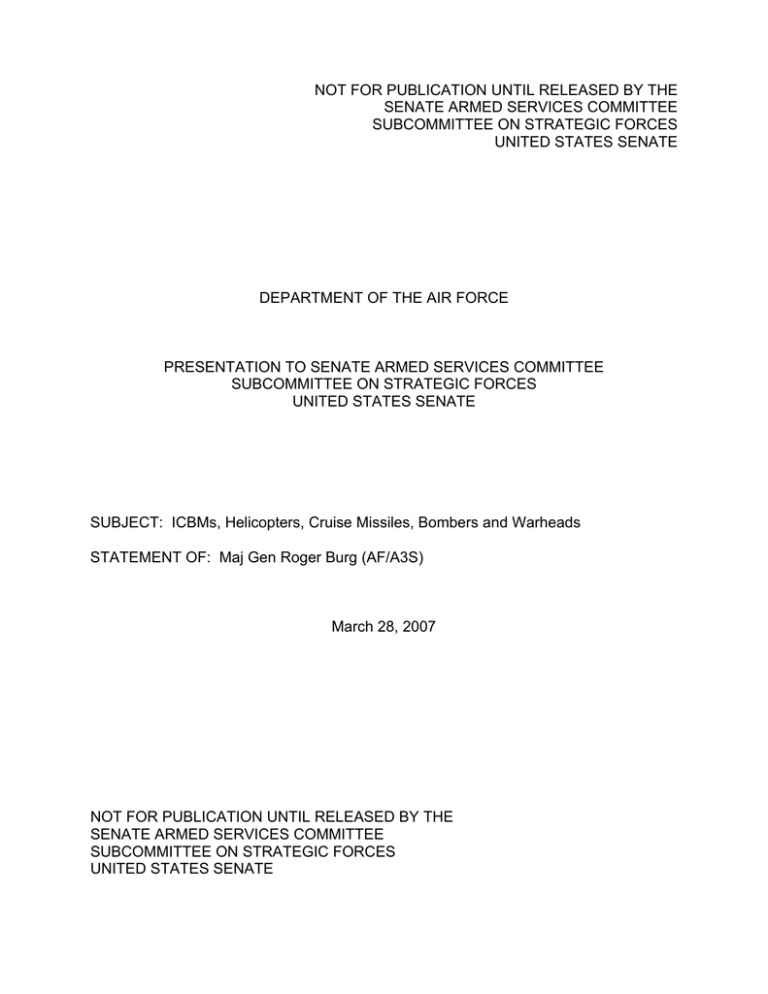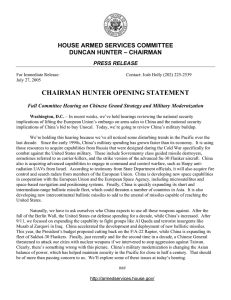NOT FOR PUBLICATION UNTIL RELEASED BY THE SENATE ARMED SERVICES COMMITTEE
advertisement

NOT FOR PUBLICATION UNTIL RELEASED BY THE SENATE ARMED SERVICES COMMITTEE SUBCOMMITTEE ON STRATEGIC FORCES UNITED STATES SENATE DEPARTMENT OF THE AIR FORCE PRESENTATION TO SENATE ARMED SERVICES COMMITTEE SUBCOMMITTEE ON STRATEGIC FORCES UNITED STATES SENATE SUBJECT: ICBMs, Helicopters, Cruise Missiles, Bombers and Warheads STATEMENT OF: Maj Gen Roger Burg (AF/A3S) March 28, 2007 NOT FOR PUBLICATION UNTIL RELEASED BY THE SENATE ARMED SERVICES COMMITTEE SUBCOMMITTEE ON STRATEGIC FORCES UNITED STATES SENATE Senate Armed Services Committee – Subcommittee on Strategic Forces March 28, 2007 Subject: ICBMs, Helicopters, Cruise Missiles, Bombers and Warheads Statement of Maj Gen Roger Burg (AF/A3S) I. Introduction Mr. Chairman and distinguished members of the subcommittee, thank you for the opportunity to appear before you today to discuss our Strategic Nuclear posture. Your Air Force is fully engaged around the world fighting terrorism and insurgents in the Global War on Terror (GWOT) and fulfilling our roles as Airmen for the joint team. Simultaneously, we stand prepared for rapid response to conflict around the globe as our Nation’s strategic reserve. Air forces succeed when they anticipate and are allowed to shape the future strategic environment and develop the capabilities for the next fight. Air forces succeed when they remain focused on their primary mission as an independent force that is part of an interdependent joint team. We fly, fight and dominate in three war fighting domains – air, space and cyberspace – giving our nation sovereign options to employ military force like no other nation. II. We Are At War Supporting U.S. Central Command (CENTCOM) and the GWOT is just a portion part of what your Air Force does for our nation’s defense. Your Air Force has responded (or been prepared to respond) across the entire spectrum of conflict – from rapid humanitarian aid to major combat operations. Page 3 Fighting and winning the GWOT is our number one priority; however, it is important that we maintain focus on protecting our nation from other potential enemies, both traditional and nontraditional. Currently, your Air Force has over 27,000 airmen, or about 5% of the Total Force deployed in support of global operations. We also have approximately 213,000 personnel, or about 40% of the total force, on-line supporting the Combatant Commands (COCOMs) daily. This number includes Airmen supporting Intercontinental Ballistic Missiles (ICBMs), missile warning and space control, the satellite control network, strategic bombers, special operations, and combat search and rescue forces. It also includes steady-state rotational forces performing a global mission but not necessarily under the direct control of a COCOM Commander or assigned to a particular area of operation (AOR). Examples include Air Expeditionary Force (AEF) postured continental U.S. fighters and theater airlift forces, base-level support troops, Air Force Major Command (MACOM) staffs, forces outside the continental U.S. assigned to Pacific Air Forces (PACAF) and U.S. Air Forces in Europe (USAFE), global support, and strategic forces. Clearly Airmen needn’t be deployed to be employed. Today’s strategic forces deliver uncompromising defense to our Nation, no differently than they have accomplished for 60 years. Since the beginnings of the Cold War, Airmen continue to stand silent sentry around the clock to protect and defend our national security, and respond to any adversary should deterrence fail. III. Strategic Nuclear Forces Air Force Intercontinental Ballistic Missiles As the Secretary of the Air Force stated in his response to concerns regarding the Minuteman III (MMIII) force reduction, “the ICBM force has provided a rapid-reaction nuclear deterrent capability since the 1960s. Today, the MMIII is the Nation’s only operational ICBM.” During Page 4 the 2005 Quadrennial Defense Review (QDR), the Defense Department agreed with U.S. Strategic Command (USSTRATCOM) recommendation to reduce the ICBM force from 500 to 450. The FY07 National Defense Authorization Act (NDAA) mandated that the Air Force modernize MMIII ICBMs in the United States inventory as required to maintain a sufficient supply of launch test assets and spares to sustain the deployed force of such missiles through 2030. The Air Force has ongoing Life Extension Programs designed to extend ICBM service life beyond 2020. Additionally, the Air Force is currently analyzing MMIII missile and ground systems to determine what activities are required to sustain the force through 2030. The Air Force plans to use an incremental approach to field an ICBM follow-on system that will address aging components while supporting COCOM requirements. The Office of the Secretary of Defense Land-Based Strategic Deterrent Overarching Integrated Product Team will review an initial system assessment in August 2007. The USAF Land-Based Strategic Deterrent Initiative will be addressed in the FY10 Program Objective Memorandum (POM). The AF will complete the concept refinement and pre-Milestone A activities this year. ICBM Demonstration Validation Responsive infrastructure is a key component of the New Triad and serves as a backstop that allows us to reduce the nuclear arsenal without compromising our strategic deterrent posture. A comprehensive and aggressive demonstration validation program adds to the deterrent value of the force. The ICBM Demonstration Validation Program is at the core of our efforts to preserve our ballistic missile capability. It allows us to respond to emerging issues in the Minuteman fleet while identifying methods to reduce life cycle costs and improve nuclear safety and surety. The unique capabilities exercised by this Program are essential to keep the Minuteman weapon system operationally viable through 2030. Page 5 ICBM Life Extension Programs (LEPs) The MMIII ICBM is undergoing major LEPs of components from the nozzle to the nose-tip, extending MM III service life through 2020 and beyond. All programs are currently on budget and on schedule. Modifications include: 1. Guidance Replacement Program: Replaces guidance set electronics on MMIII and improves reliability on the ground and in flight. A total of 440 sets have been delivered and the program will be complete with the delivery of the final 32 guidance sets in FY07. 2. Propulsion Replacement Program: Extends booster life through 2020 by re-pouring stages one and two, and re-manufacturing stage three. A total of 311 boosters have been delivered. The program will be complete with the delivery of the final 56 booster sets in FY08. 3. Propulsion System Rocket Engine Program: Refurbishes seven components and assemblies in the liquid propulsion post-boost vehicle. A total of 72 kits have been installed and we will purchase 96 additional kits in FY08. 4. Safety Enhanced Reentry Vehicle: Enables MMIII to carry the more advanced Peacekeeper MK 21 Reentry Vehicle (RV) while retaining the powerful MMIII MK 12A RV multiple independently re-targetable RV (MIRV) capability. Retirement of the older MK 12 RV is now possible, allowing us to avoid a costly $1B LEP. A total of 20 kits have been installed and we will purchase an additional 120 kits in FY08. 5. Environmental Control System: Modernizes cooling system equipment in the Minuteman Launch Facilities and Missile Alert Facilities. Five kits have been installed and we will purchase 112 kits in FY08. We are not planning to modify the facilities assigned to the 564th Missile Squadron at Malmstrom AFB, MT as a result of the planned reduction in the MMIII ICBM force. Page 6 6. ICBM Security Modernization Program: This three-part program consists of concrete enhancements, a fast-rising secondary personnel access hatch, and a Remote Visual Assessment (RVA) camera. This comprehensive program began in FY04. Our FY08 program includes the purchase of 100 fast-rising hatches which will allow responding Security Forces adequate time to deny access to our launch facilities. Our FY08 program also purchases 60 RVA units. We are not planning to modify facilities assigned to the 564th Missile Squadron at Malmstrom AFB, MT as a result of the planned reduction in the MMIII ICBM force. Helicopters The primary Air Force Space Command (AFSPC) helicopter mission is to provide our Security Forces with a continuous contingency response capability for the national ICBM complex. However, the Bell UH-1N is not capable of meeting current security requirements. It does not meet Key Performance Parameters for speed, endurance, range, or payload. UH-1Ns are not armed with offensive weapons, have no defensive capabilities or countermeasures, and cannot operate in a Chemical, Biological, Radiological, Nuclear (CBRN) environment. Our average Air Force UH-1N airframe is 38 years old. The original design life for this aircraft was 2,500 flying hours, although some aircraft in the inventory have over 13,000 hours. The UH-1N fleet is showing its age with fatigue-related cracks in the tail boom and is currently undergoing its second tail boom replacement enabling it to meet flight safety standards. The Common Vertical Lift Support Platform (CVLSP) is an Air Force effort to replace the UH-1N. The CVLSP was originally envisioned as a variant of CSAR-X. The Joint Requirements Oversight Council directed that the efforts be separated and then directed AFSPC to conduct a separate CVLSP Analysis of Alternatives (AoA). The CVLSP AoA is now complete and is in coordination at the Air Staff. CVLSP is sixth on the Air Force’s Unfunded Priority List. Page 7 The AFSPC team is considering four CVLSP options: 1. CSAR-X platform 2. Rebuild Air Combat Command service life extension program-modified HH-60G aircraft 3. Develop a new aircraft 4. Continue using the UH-1N aircraft Nuclear Cruise Missiles The Air Force analyzed current and future roles for nuclear cruise missiles during the 2005 QDR and the FY07 Amended POM (APOM). The Defense Department issued guidance on 20 December 2005 directing USSTRATCOM and the Air Force to study the nuclear cruise missile force structure, including the Air-to-Ground Missile (AGM) -86 Air Launched Cruise Missile (ALCM) and the AGM-129 Advanced Cruise Missile (ACM). The guidance also directed us to build a retirement schedule for the missiles. The resulting study recommended that the Air Force retire all ACMs, reduce the ALCM force to 528, retire all excess ALCMs, consolidate the ALCM force at Minot AFB, and retain ALCMs in the inventory through at least 2020, possibly 2030. On 12 April 2006, the Deputy Secretary of Defense accepted the study recommendations. On 23 June 2006, the Commander, USSTRATCOM sent a letter to the Secretary of Defense supporting the study findings and advocating adoption of the ALCM/ACM force structure recommendations. The Joint Chiefs of Staff and National Security Council endorsed most of the study recommendations. On 17 October 2006 the Secretary of Defense directed the Air Force to retire the ACM and reduce the ALCM fleet to 528 missiles. The Air Force intends to remove from service, demilitarize and destroy all ACMs and the excess ALCM missile bodies. The remaining nuclear cruise missile force will be consolidated at Minot AFB, North Dakota. As of this date, the Air Force has taken no irreversible actions as it seeks final congressional approval to demilitarize and destroy these missile bodies. These cruise Page 8 missile force structure changes are part of a balanced force reduction that supports both Presidential direction to reduce the active nuclear stockpile, as well as the United States’ obligation under the 2002 Moscow Treaty to reduce the number of operationally deployed strategic nuclear warheads to 1700-2200 warheads. Strategic Bombers We have no plans to change the current force of B-1 and B-2 aircraft. Our strategy for the future bomber fleet includes a three-phased modernization plan. The first phase of the modernization strategy includes plans for us to divest 38 B-52s while modernizing the remaining legacy systems. President’s Budget FY08 funded a B-52 force structure consisting of 56 B-52 Total Aircraft Inventory (TAI). This inventory included 32 Combat Coded (CC), 11 Training (TF), four Test, and nine backup B-52s. Following submission of the FY08 POM to OSD, Congress mandated that the Air Force “not retire more than 18 B-52s (FY07 retirements) and maintain 44 B-52s as Combat Coded.” The Headquarters Air Force, Air Combat Command (ACC), and the Air Force Reserve Center are working together to abide by this restriction while meeting the Air Force need to recapitalize aging aircraft. ACC is finalizing a plan to recode 11 TF B-52s and one test B-52 which would result in a total of 44 Combat Coded B-52s. The 20 B52s the Air Force plans to retire in Fiscal Year 2008 will be stored on the ramps at Barksdale AFB and Minot AFB in XJ status, which means that the Air Force will keep these aircraft in a serviceable condition but not in a common configuration (i.e. no capability upgrades) with the other 56 aircraft. The FY08 President’s Budget reflects the Air Force position. A fleet of 56 TAI B-52s with 32 coded for combat meets AF requirements while supporting the need to recapitalize. The FY07 NDAA mandated that no funds “be obligated or expended for retiring any of the 93 B-52H bomber aircraft in service in the Air Force as of the date of the enactment of this Act until 45 Page 9 days after the date on which the Secretary of the Air Force submits a Bomber force structure report prepared by the Institute for Defense Analyses (IDA).” The Air Force expects the report to be finished by the end of 2007. The second and third phases of the modernization strategy include fielding a next-generation long range strike (NGLRS) capability by 2018 and fielding an advanced technology system with increased speed, range, precision, connectivity and survivability by 2035. Reliable Replacement Warhead Reliable Replacement Warhead (RRW) designs incorporate a broad suite of enhanced safety features which increases efficiency and cost-effectiveness as well as improved security features to prevent unauthorized use by terrorists, rogue nations or criminal organizations. These designs will replace 1970s-era technologies with modern components which will help minimize future safety and security uncertainties and can be managed using the improved computational and experimental tools developed by the Stockpile Surveillance Program. An all-RRW force is sustainable well into the future providing our combatant commanders with high confidence while managing risk. In November 2006 the Nuclear Weapons Council commissioned an RRW-2 Phase 1 Study. The purpose of the year-long study is to define concepts for a replacement warhead to existing and future air-delivered systems. The study group is analyzing preliminary concept assessments, identifying delivery systems, recommending nuclear weapon trade-offs, and proposing an initial program schedule. IV. Closing We are building an Air Force prepared to dominate in the 21st century – strategically, operationally, and tactically. Air Force Strategic forces, the bulwark of our strategic deterrent Page 10 capability, give us the means to ensure Global Vigilance, Global Reach, Global Power, and worldwide Expeditionary Combat Support. These capabilities are essential to the joint fight and are a critical component of the future joint force. The Air Force is committed to advancing strategic capabilities to fully support the joint team. In order to maintain our strategic dominance, the AF must recapitalize and also be allowed to divest itself of outdated, excess platforms. Divesting excess platforms will provide the means to shift vital funds to recapitalization and modernization of our Air Force and to maintain a strategic deterrent second to none. We appreciate your continued support in turning our vision into an operational reality. Our nation must invest today to ensure tomorrow’s air, space and cyberspace dominance.






